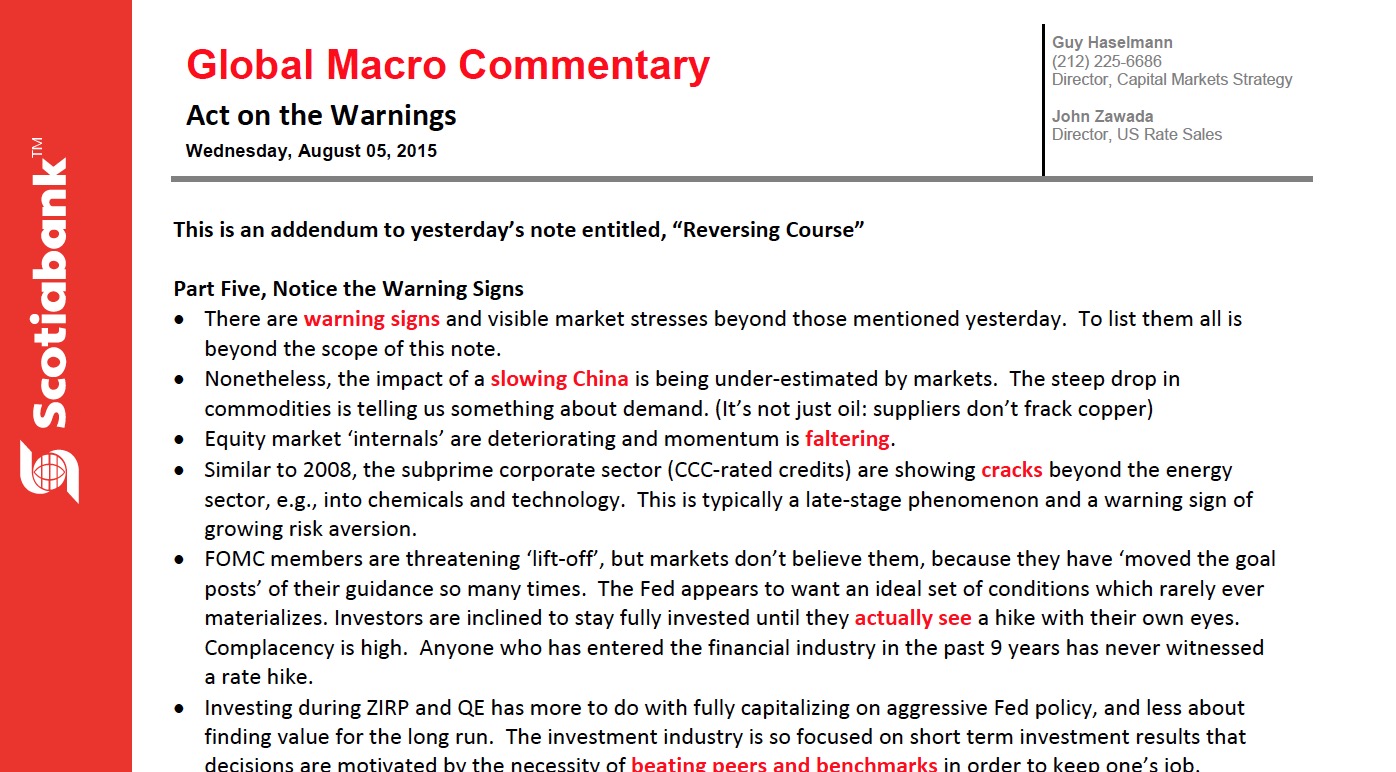This is an addendum to yesterday’s note entitled, “Reversing Course”
by Guy Haselmann, Director, Capital Markets Strategy, Scotiabank GBM
Part Five, Notice the Warning Signs
• There are warning signs and visible market stresses beyond those mentioned yesterday. To list them all is beyond the scope of this note.
• Nonetheless, the impact of a slowing China is being under-estimated by markets. The steep drop in commodities is telling us something about demand. (It’s not just oil: suppliers don’t frack copper)
• Equity market ‘internals’ are deteriorating and momentum is faltering.
• Similar to 2008, the subprime corporate sector (CCC-rated credits) are showing cracks beyond the energy sector, e.g., into chemicals and technology. This is typically a late-stage phenomenon and a warning sign of growing risk aversion.
• FOMC members are threatening ‘lift-off’, but markets don’t believe them, because they have ‘moved the goal posts’ of their guidance so many times. The Fed appears to want an ideal set of conditions which rarely ever materializes. Investors are inclined to stay fully invested until they actually see a hike with their own eyes. Complacency is high. Anyone who has entered the financial industry in the past 9 years has never witnessed a rate hike.
• Investing during ZIRP and QE has more to do with fully capitalizing on aggressive Fed policy, and less about finding value for the long run. The investment industry is so focused on short term investment results that decisions are motivated by the necessity of beating peers and benchmarks in order to keep one’s job.
• Yet, “lift-off” will reduce the Fed’s subsidy. Total rate normalization is the removal of ‘the gift’ provided to the private sector. The process in getting there will be the catalyst that begins the reduction of carry trades and market speculation.
• Positional unwinds may begin as a trickle, but morph into a cascade. Those who try to hold on will likely confront a shrinking Fed balance sheet in 2016. Investors should do their own homework to understand what this is likely to mean for risk assets (Hint: it’s not a good result).
Part Six, Portfolio Adjustment Recommendations During Policy Pivot (with a few forecasts thrown in)
• Raise cash levels. Cash has great optionality enables it to be deployed at better levels. With rates so low, cash has never had such a low opportunity cost.
• Increase portfolio liquidity, while reducing portfolio volatility.
• Buy long-dated on-the-run Treasury securities, or the highest quality and most liquid corporate bonds. I expect an abrupt ‘risk-off’ trade as the Fed begins ‘normalization’ that will bring UST 10’s and 30’s well thru 2% and 2.75%, respectively. I can envision this happening prior to the September FOMC meeting.
o If the Fed hikes it will likely help the long end.
o If the global economy sputters due to China or due to other factors that force the Fed to remain on hold, then long Treasuries will again perform well.
o If the Fed loses its window of opportunity to hike due to worsening financial and economic conditions then it has few tools left to provide further stimulus. Moreover, markets might begin to question the effectiveness of past actions and not believe future ones. In such, cries of “more Fed” which have benefited financial assets over the past few years would no longer help risk assets.
• Own US Treasuries versus European debt.
• Investors should decrease trades that try to play the Fed subsidy too aggressively even in a world of ‘gradual’.
• Take down equity beta and hidden betas. Hedge, buy puts, sell calls, and buy tail risk on equity exposures.
• Set up for a long term structural bull market in the US Dollar.
o As mentioned, slowing demand for industrial commodities from China is putting significant pressure on the budgets of emerging market countries and commodity exporters. Some of these countries may be incentivized to boost revenues by selling more at discounted prices. EM currencies have been leaking lower all year and have room to fall to levels not seen since the early part of this century. (Own USD: EM = lower still, EUR<100, $/CAD>1.40, AUD<.6500)
• Commodities are over-sold, but have been struggling to have any bounce at all. This week the CRB commodity index fell below its 2009 low, sinking to a level last seen in 2003. In many areas, supply continues to surpass any increases in demand. Oil risks testing the $40 support level. Other industrial commodities risk falling to multi-decade lows. (Supply destruction takes time, and demand is slow to pick up).
• Investor outperformance in the next year will likely come from defensive strategies and reversing to risk under-weights with an emphasis on liquidity and reducing portfolio volatility.
“Actions speak louder than words, but not nearly as often” – Mark Twain
Regards,
Guy
Guy Haselmann | Capital Markets Strategy
▬▬▬▬▬▬▬▬▬▬▬▬▬▬▬▬▬▬▬▬▬▬▬▬▬▬▬
Scotiabank | Global Banking and Markets
250 Vesey Street | New York, NY 10281
T-212.225.6686 | C-917-325-5816
guy.haselmann[at]scotiabank.com
Scotiabank is a business name used by The Bank of Nova Scotia
Read/Download the complete report below:













